Bài giảng Kiến trúc phần mềm - Chương: Quy trình kiến trúc phần mềm - Trần Minh Triết
A Software Architecture Process
Architects must be versatile:
Work with the requirements team: The architect plays
an important role in requirements gathering by
understanding the overall systems needs and ensuring
that the appropriate quality attributes are explicit and
understood.
Work with various application stakeholders: Architects
play a pivotal liaison role by making sure all the
application‟s stakeholder needs are understood and
incorporated into the design.
Lead the technical design team: Defining the
application architecture is a design activity.
Work with the project management: Planning,
estimates, budgets, schedules

Trang 1
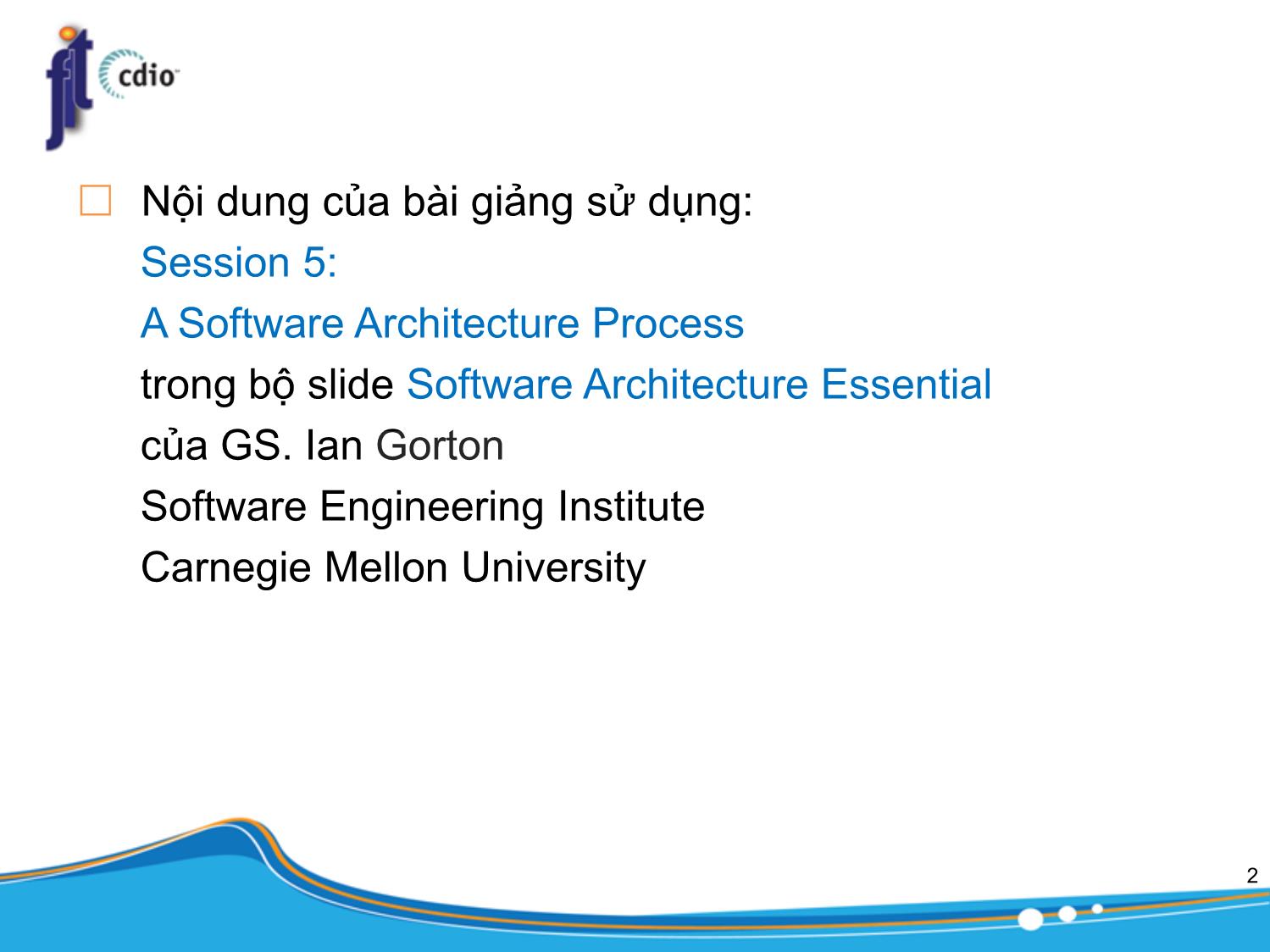
Trang 2
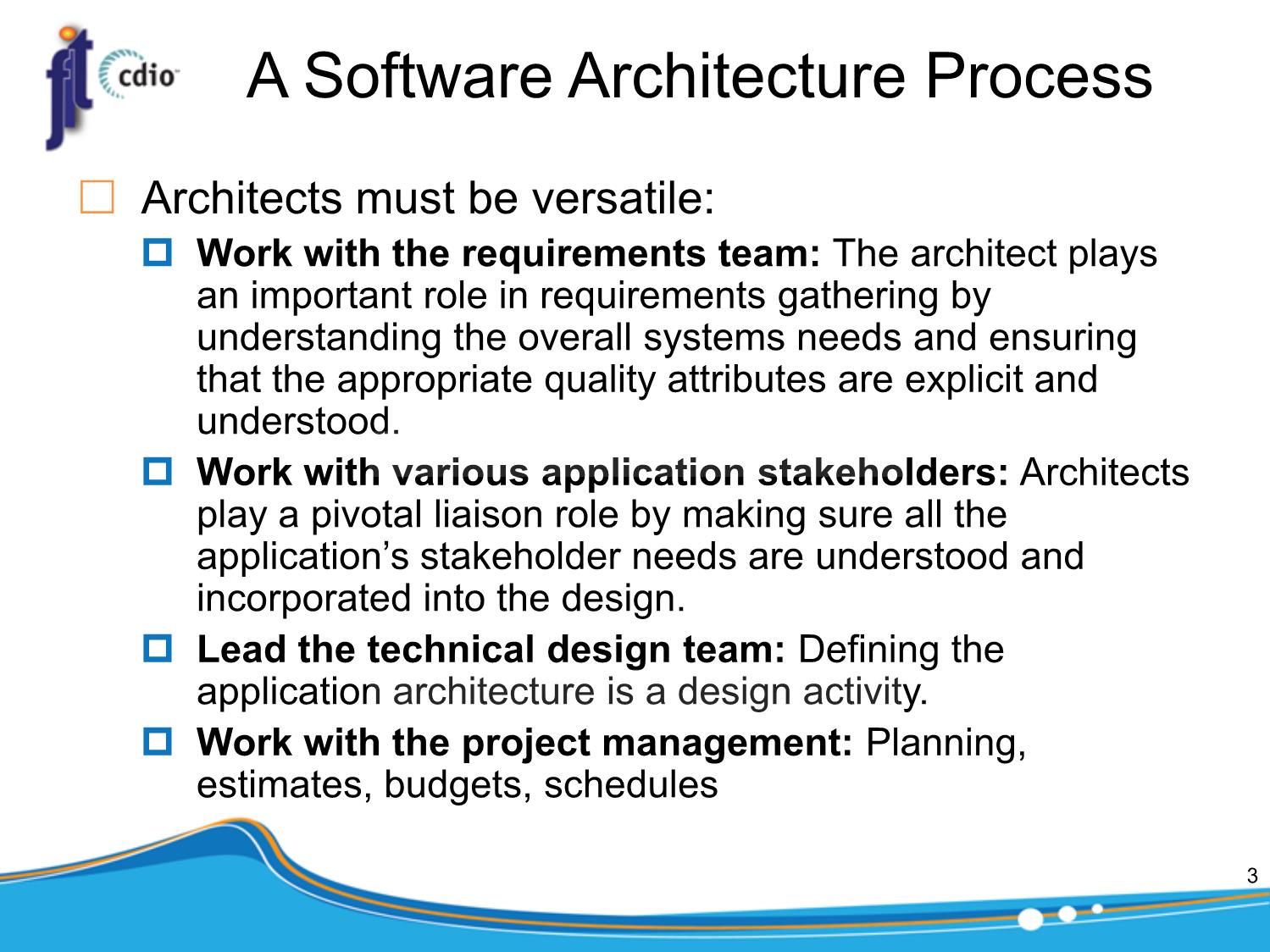
Trang 3
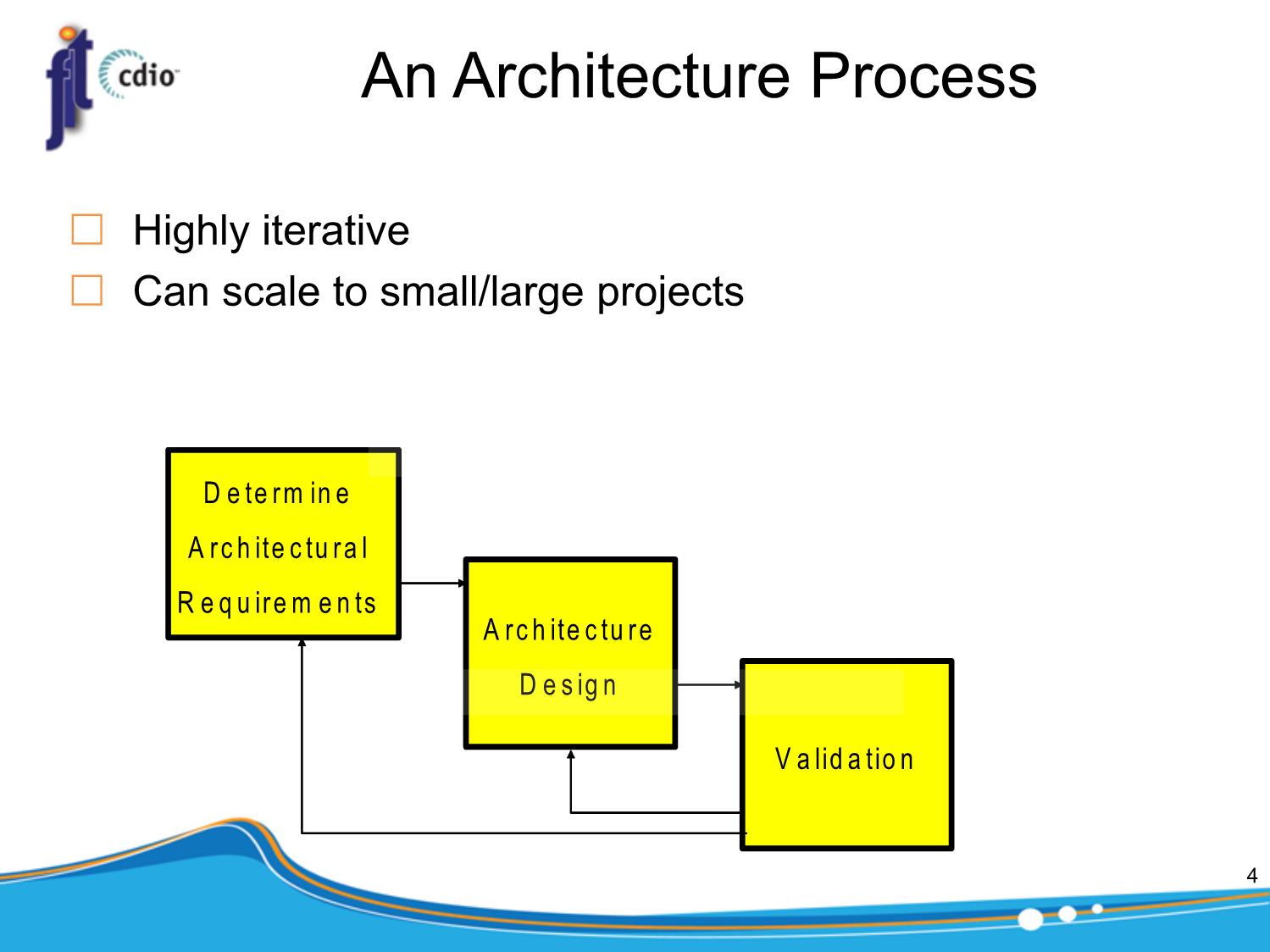
Trang 4
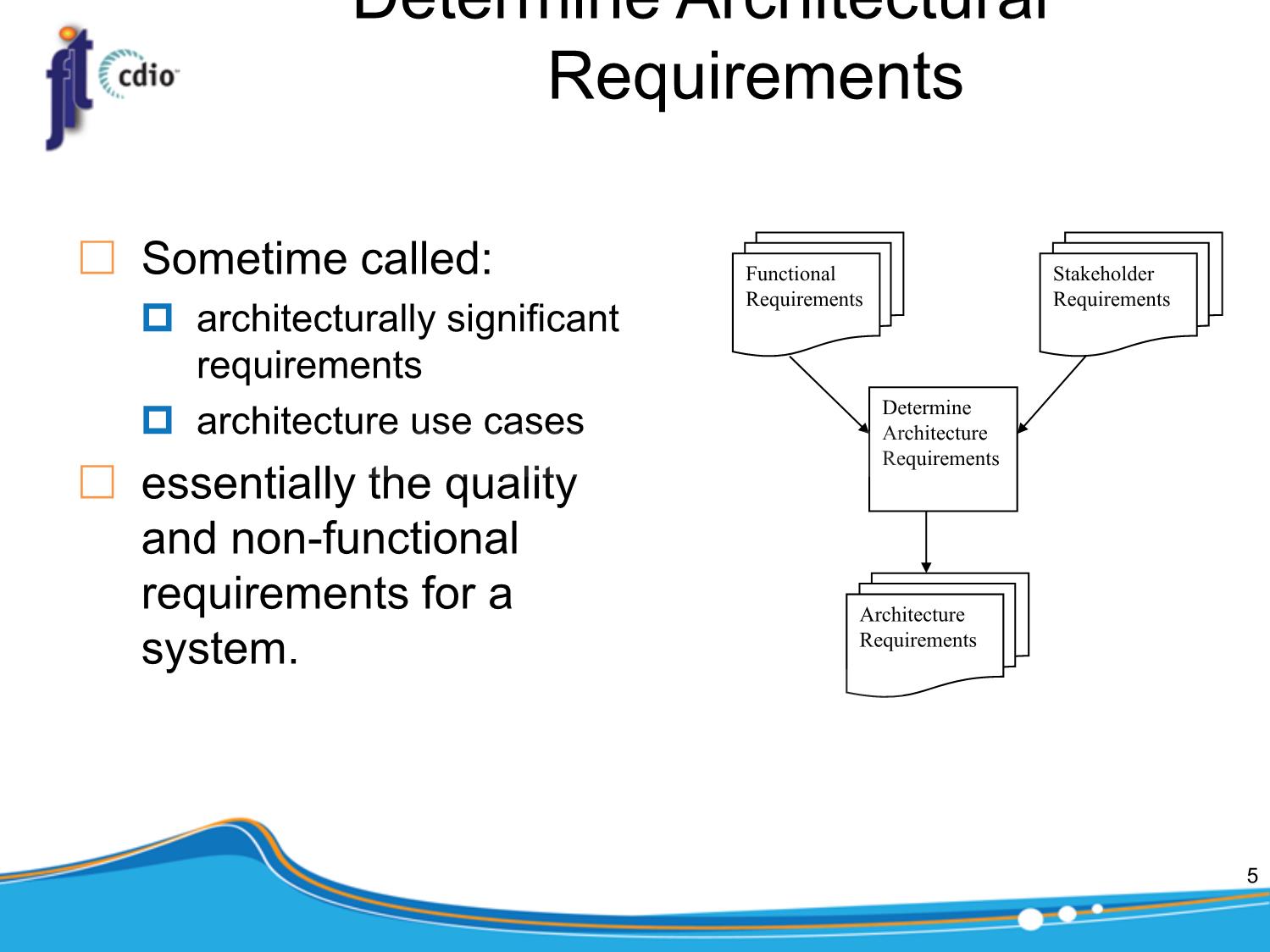
Trang 5
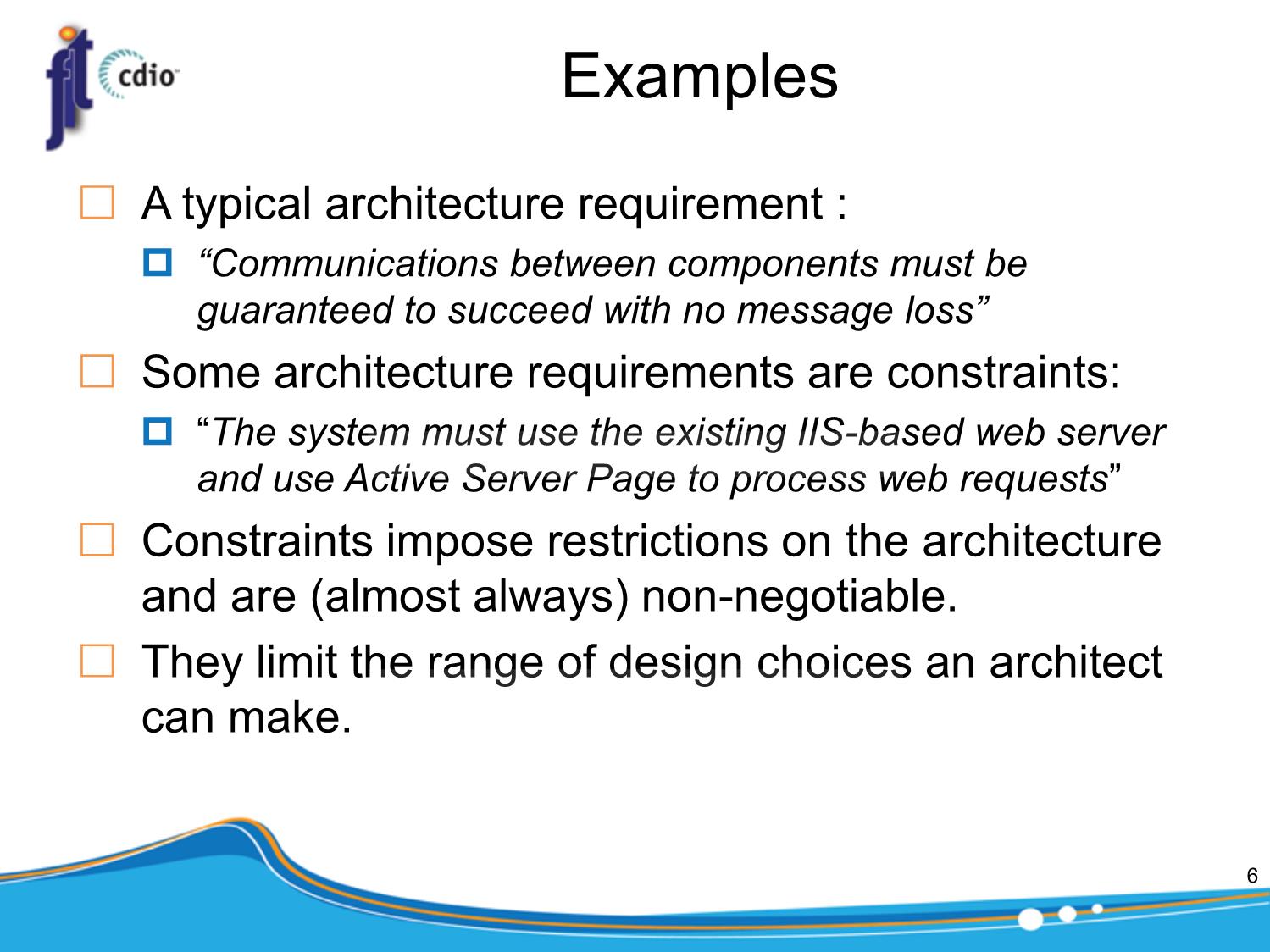
Trang 6
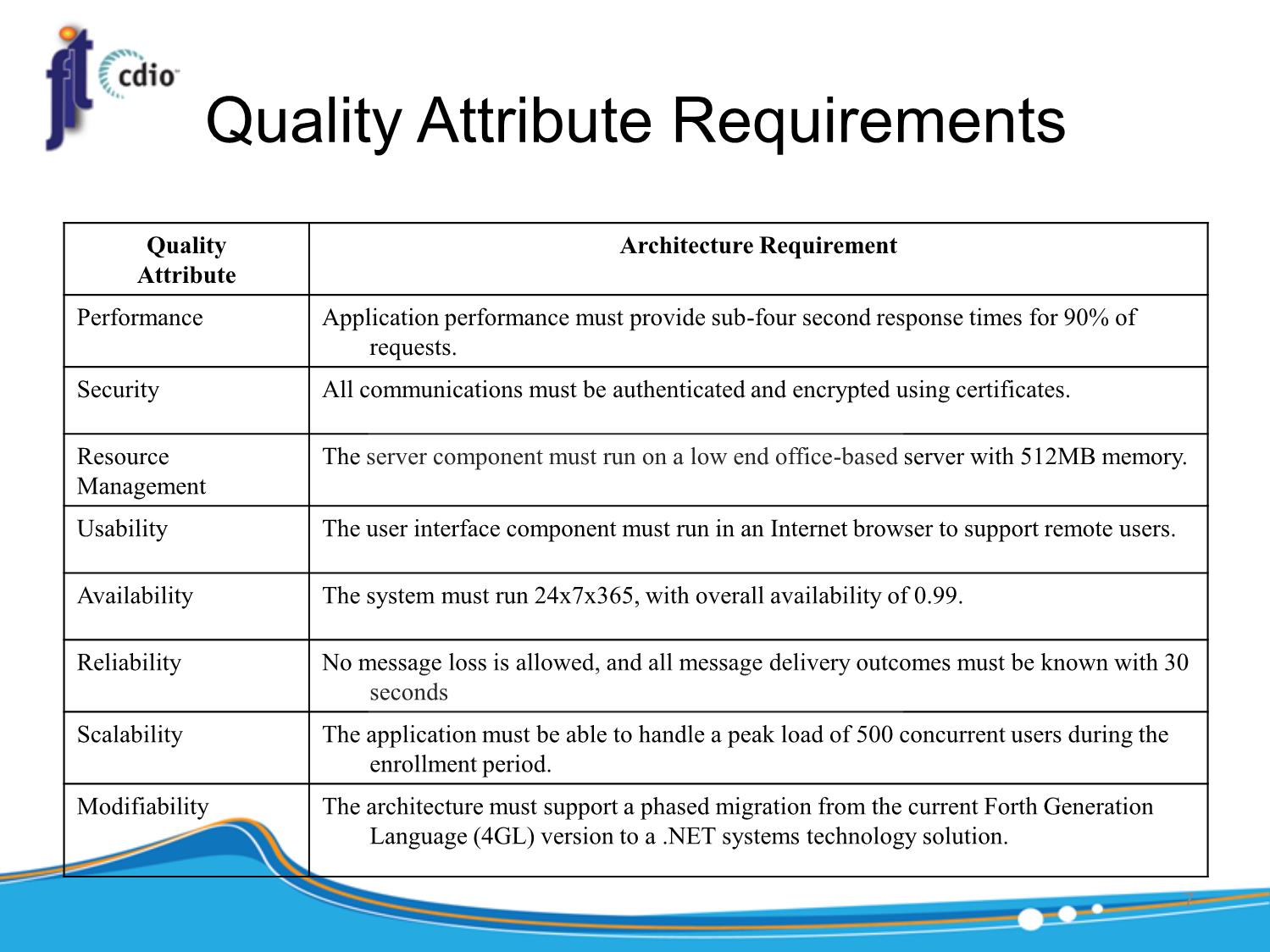
Trang 7
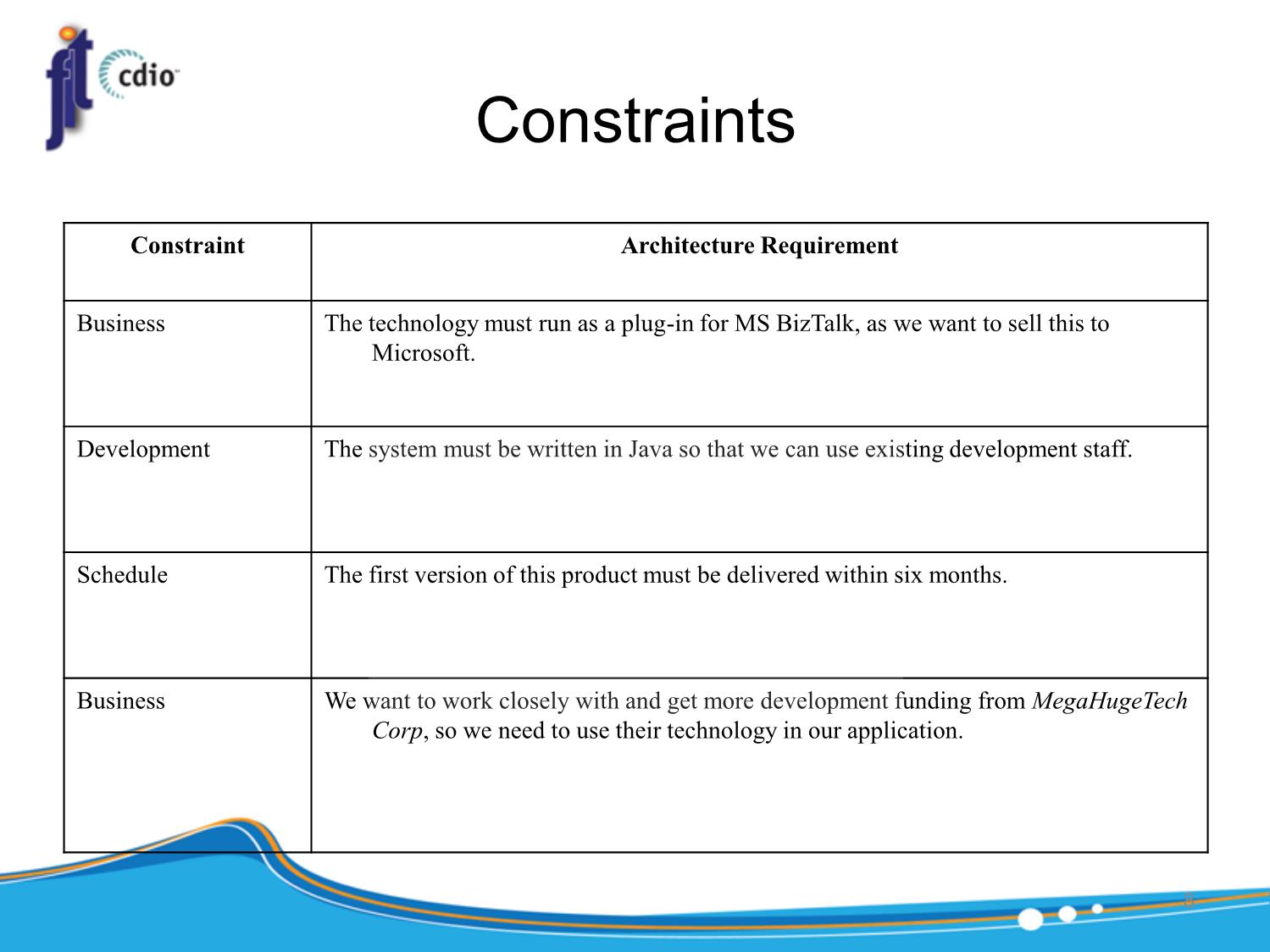
Trang 8
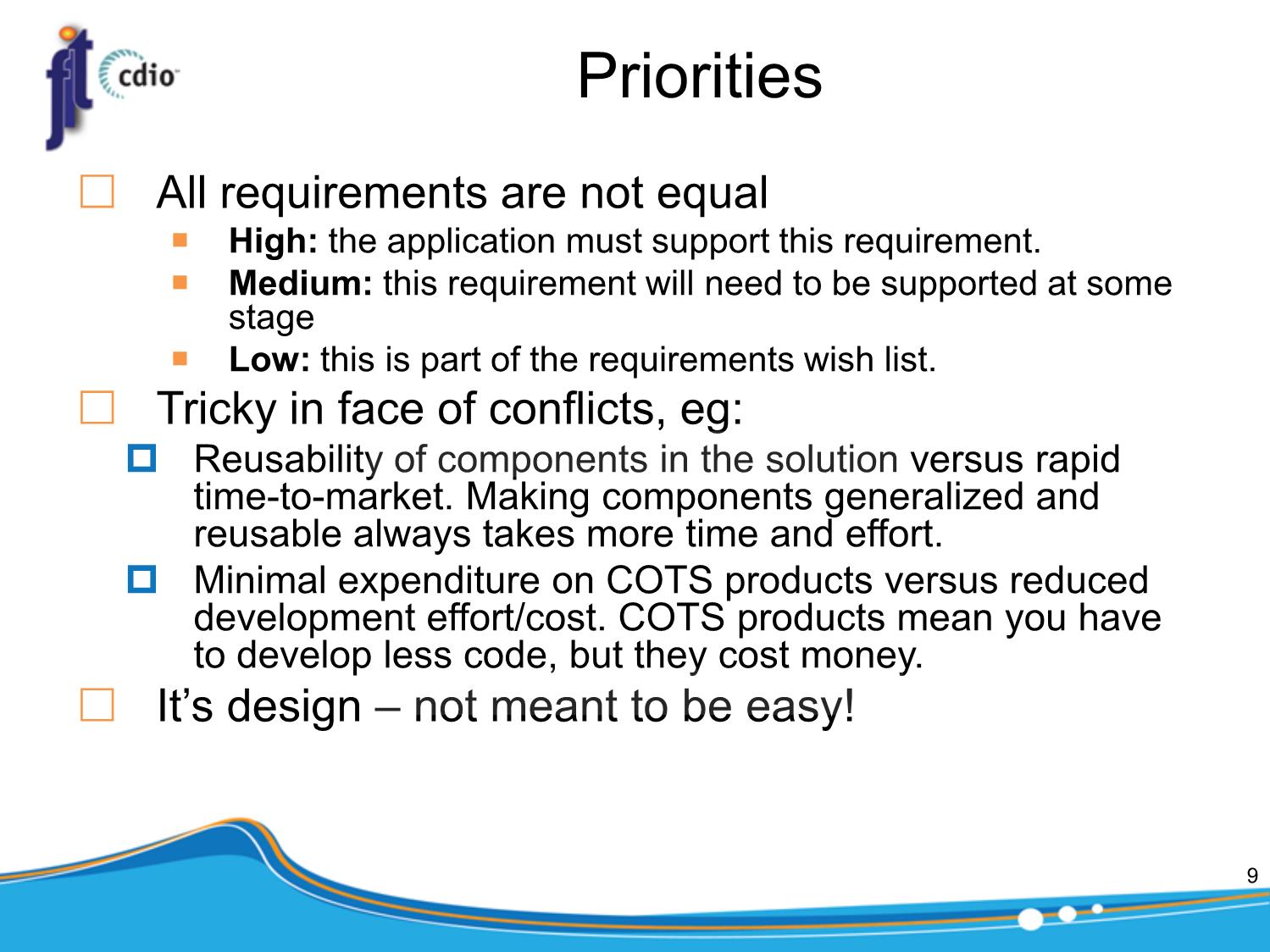
Trang 9
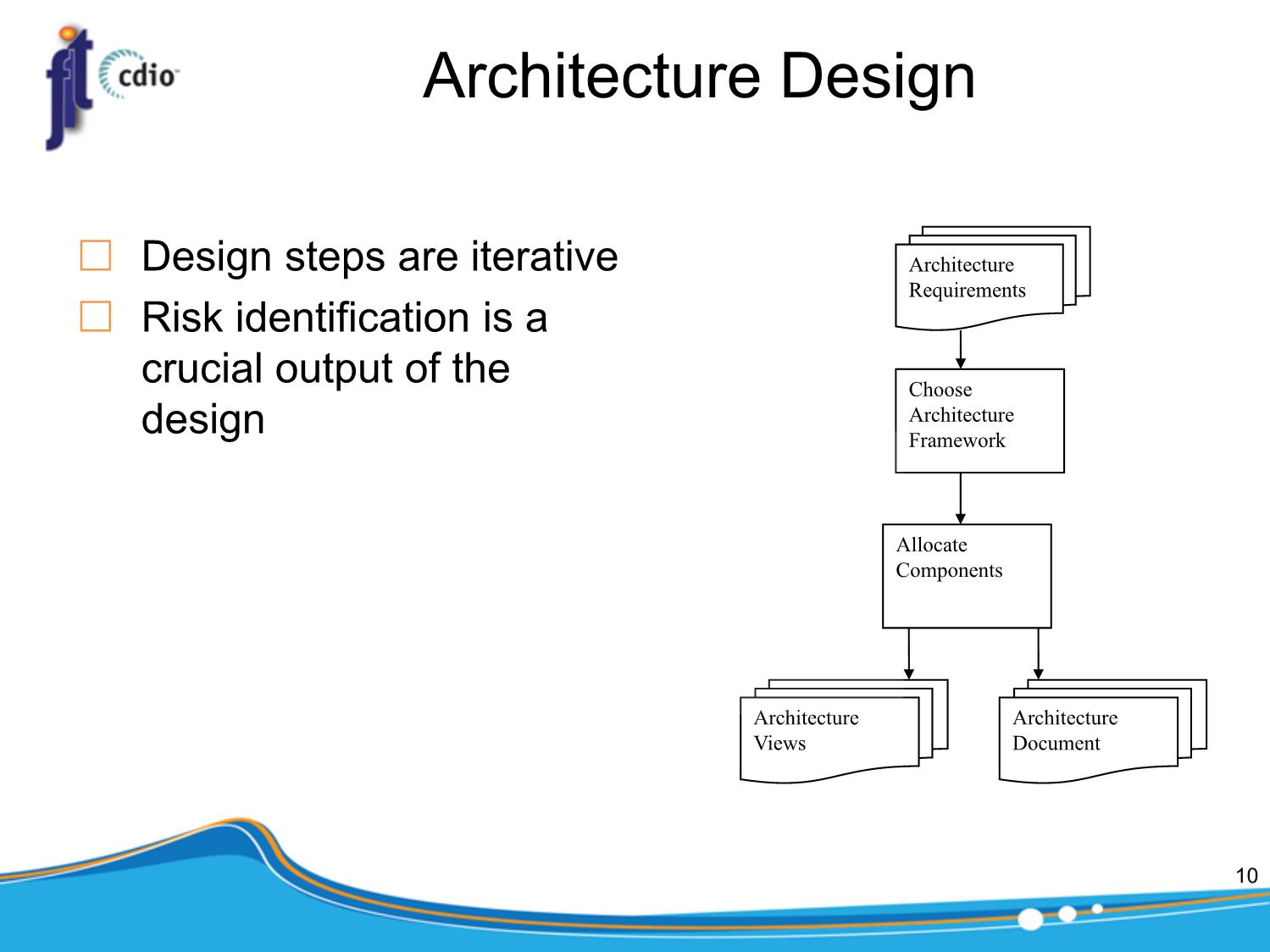
Trang 10
Tải về để xem bản đầy đủ
Bạn đang xem 10 trang mẫu của tài liệu "Bài giảng Kiến trúc phần mềm - Chương: Quy trình kiến trúc phần mềm - Trần Minh Triết", để tải tài liệu gốc về máy hãy click vào nút Download ở trên
Tóm tắt nội dung tài liệu: Bài giảng Kiến trúc phần mềm - Chương: Quy trình kiến trúc phần mềm - Trần Minh Triết

al logic modified in many cases without changes rippling into other tiers. Performance This architecture has proven high performance. Key issues to consider are the amount of concurrent threads supported in each server, the speed of connections between tiers and the amount of data that is transferred. As always with distributed systems, it makes sense to minimize the calls needed between tiers to fulfill each request. Scalability As servers in each tier can be replicated, and multiple server instances run on the same or different servers, the architecture scales out and up well. In practice, the data management tier often becomes a bottleneck on the capacity of a system. 13 Messaging Pattern Asynchronous communications: Clients send requests to the queue, where the message is stored until an application removes it. Configurable Client Server QoS: The queue can be Client Que Server configured for high-speed, Client ue Server non-reliable or slower, reliable delivery. Queue operations can be coordinated with database transactions. Loose coupling: There is no direct binding between clients and servers. 14 Messaging – Quality Attribute Analysis Quality Issues Attribute Availability Physical queues with the same logical name can be replicated across different messaging server instances. When one fails, clients can send messages to replica queues. Failure handling If a client is communicating with a queue that fails, it can find a replica queue and post the message there. Modifiability Messaging is inherently loosely coupled, and this promotes high modifiability as clients and servers are not directly bound through an interface. Changes to the format of messages sent by clients may cause changes to the server implementations. Self-describing, discoverable message formats can help reduce this dependency on message formats. Performance Message queuing technology can deliver thousands of messages per second. Non- reliable messaging is faster than reliable, with the difference dependent of the quality of the messaging technology used. Scalability Queues can be hosted on the communicating endpoints, or be replicated across clusters of messaging servers hosted on a single or multiple server machines. This makes messaging a highly scalable solution. 15 Publish-Subscribe Pattern Many-to-Many messaging: Published messages are sent to all subscribers who are registered with the topic. Configurable QoS: In addition to non-reliable and Subscriber reliable messaging, the Publisher Topic Subscriber underlying communication Subscriber mechanism may be point-to- point or broadcast/multicast. Loose Coupling: As with messaging, there is no direct binding between publishers and subscribers. 16 Publish-Subscribe – Quality Attribute Analysis Quality Issues Attribute Availability Topics with the same logical name can be replicated across different server instances managed as a cluster. When one fails, publishers send messages to replica queues. Failure handling If a publisher is communicating with a topic hosted by a server that fails, it can find a live replica server and send the message there. Modifiability Publish-subscribe is inherently loosely coupled, and this promotes high modifiability. New publishers and subscribers can be added to the system without change to the architecture or configuration. Changes to the format of messages published may cause changes to the subscriber implementations. Performance Publish-subscribe can deliver thousands of messages per second, with non- reliable messaging faster than reliable. If a publish-subscribe broker supports multicast/broadcast, it will deliver multiple messages in a more uniform time to each subscriber. Scalability Topics can be replicated across clusters of servers hosted on a single or multiple server machines. Clusters of server can scale to provide very high message volume throughput. Also, multicast/broadcast solutions scale better than their point-to-point counterparts. 17 Broker Pattern Hub-and-spoke architecture: The broker acts as a messaging hub, and senders and receivers connect as spokes. inPort1 OutPort1 Sender-1 Receiver-1 Performs message routing: The broker embeds processing Broker logic to deliver a message received on an input port to an output port. Sender-2 Receiver-2 Performs message inPort2 OutPort2 transformation: The broker logic transforms the source message type received on the input port to the destination message type required on the output port. 18 Broker Pattern - Quality Attribute Analysis Quality Issues Attribute Availability To build high availability architectures, brokers must be replicated. This is typically supported using similar mechanisms to messaging and publish-subscribe server clustering. Failure handling As brokers have typed input ports, they validate and discard any messages that are sent in the wrong format. With replicated brokers, senders can fail over to a live broker should one of the replicas fail. Modifiability Brokers separate the transformation and message routing logic from the senders and receivers. This enhances modifiability, as changes to transformation and routing logic can be made without affecting senders or receivers. Performance Brokers can potentially become a bottleneck, especially if they must service high message volumes and execute complex transformation logic. Their throughput is typically lower than simple messaging with reliable delivery. Scalability Clustering broker instances makes it possible to construct systems scale to handle high request loads. 19 Process Coordinator Pattern Process encapsulation: The process coordinator encapsulates the sequence of Start process Process steps needed to fulfill the request results business process. The Process sequence can be arbitrarily Coordinator complex. Loose coupling: The server components are unaware of step1 their role in the overall business step2 step3 step4 process, and of the order of the steps in the process. Flexible communications: Server-1 Server-2 Server-3 Server-4 Communications between the coordinator and servers can be synchronous or asynchronous. 20 Process Coordinator – Quality Attribute Analysis Quality Issues Attribute Availability The coordinator is a single point of failure. Hence it needs to be replicated to create a high availability solution. Failure handling Failure handling is complex, as it can occur at any stage in the business process coordination. Failure of a later step in the process may require earlier steps to be undone using compensating transactions. Handling failures needs careful design to ensure the data maintained by the servers remains consistent. Modifiability Process modifiability is enhanced because the process definition is encapsulated in the coordinator process. Servers can change their implementation without affecting the coordinator or other servers, as long as their external service definition doesn’t change. Performance To achieve high performance, the coordinator must be able to handle multiple concurrent requests and manage the state of each as they progress through the process. Also, the performance of any process will be limited by the slowest step, namely the slowest server in the process. Scalability The coordinator can be replicated to scale the application both up and out. 21 Allocate Components Need to: Identify the major application components, and how they plug into the framework. Identify the interface or services that each component supports. Identify the responsibilities of the component, stating what it can be relied upon to do when it receives a request. Identify dependencies between components. Identify partitions in the architecture that are candidates for distribution over servers in a network And independent development 22 Some Design Guidelines Minimize dependencies between components. Strive for a loosely coupled solution in which changes to one component do not ripple through the architecture, propagating across many components. Remember, every time you change something, you have to re- test it. Design components that encapsulate a highly “cohesive” set of responsibilities. Cohesion is a measure of how well the parts of a component fit together. Isolate dependencies on middleware and any COTS infrastructure technologies. Use decomposition to structure components hierarchically. Minimize calls between components, as these can prove costly if the components are distributed. 23 A Simple Design Example read Write Order OrderQ New OrderInput Orders Get Order Check Write Order Order SendEmail Validate Store Error Log Customer Order Email System System Server Figure Key Existing Component Database New Persistent Component Queue Dependency 24 Example Design Based on messaging Application components are: OrderInput: responsible for accessing the new orders database, encapsulating the order processing logic, and writing to the queue. Validate: encapsulates the responsibility of interacting with the customer system to carry out validation, and writing to the error logs if an order is invalid. Store: responsibility of interacting with the order system to store the order data. SendEmail: removes a message from the queue, formats an email message and sends it via an email server. It encapsulates all knowledge of the email format and email server access. Clear responsibilities and dependencies 25 Architecture Validation Aim of the validation phase is to increase confidence of the design team that the architecture is fit for purpose. The validation has to be achieved within the project constraints of time and budget The trick is to be as rigorous and efficient as possible. Validating an architecture design poses tough challenges. „coz it‟s a design that can‟t be executed or tested consists of new and COTS components that have to be integrated Two main techniques: 1. manual testing of the architecture using test scenarios. 2. construction of a prototype that creates a simple archetype of the desired application aim of both is to identify potential flaws in the design so that they can be improved before implementation commences. Cheaper to fix before built 26 Scenarios Part of SEI‟s ATAM work Involves defining: some kind of stimulus that will have an impact on the architecture. working out how the architecture responds to this stimulus. If the response is desirable, then a scenario is deemed to be satisfied by the architecture. If the response is undesirable, or hard to quantify, then a flaw or at least an area of risk in the architecture may have been uncovered. 27 Scenario Examples Quality Stimulus Response Attribute Availability The network connection to the Messages are stored on the MOM server until the message consumers fails. connection is restored. Messages will only be lost if the server fails before the connection comes back up. Modifiability A new set of data analysis The application needs to be rebuilt with the new components must be made libraries, and the all configuration files must be available in the application. updated on every desktop to make the new components visible in the GUI toolbox. Security No requests are received on a user The system treats this session as potentially insecure session for ten minutes. and invalidates the security credentials associated with the session. The user must logon again to connect to the application. Modifiability The supplier of the transformation A new transformation engine must be purchased. engine goes out of business. The abstract service layer that wraps the transformation engine component must be re- implemented to support the new engine. Client components are unaffected as they only use the abstract service layer. Scalability The concurrent user request load The application server is scaled out on a two doubles during the 3 week machine cluster to handle the increased request enrollment period. load. 28 Scenarios for Order Processing Example Quality Stimulus Response Attribute Modifiability The Customer System packaged The Validate component must be rewritten to application is updated to an Oracle interface to the Oracle system. database. Availability The email server fails. Messages build up in the OrderQ until the email server restarts. Messages are then sent by the SendEmail component to remove the backlog. Order processing is not affected. Reliability The Customer or Order systems are If either fails, order processing halts and alerts unavailable. are sent to system administrators so that the problem can be fixed. Needs fixing . 29 Prototyping Scenarios can‟t address everything: “On Friday afternoon, orders must be processed before close- of-business to ensure delivery by Monday. Five thousand orders arrive through various channels (Web/Call centre/business partners) five minutes before close-of- business.” Only one way – build something! Proof-of-concept prototype: Can the architecture as designed be built in a way that can satisfy the requirements? Proof-of-technology prototype : Does the technology (middleware, integrated applications, libraries, etc) selected to implement the application behave as expected? 30 Prototyping Strategy Build minimal system required to validate architecture, eg: An existing application shows that the queue and email systems are capable of supporting five thousand messages in five minutes So: Write a test program that calls the Customer System validation APIs five thousand times, and time how long this takes. Write a test program that calls the Order System store APIs five thousand times, and time how long this takes. 31 Prototyping Thoughts Prototypes should be used judiciously to help reduce the risks inherent in a design. Only way to address: Performance Scalability Ease of integration Capabilities of off-the-shelf components Need to be carefully scoped and managed. Ideally take a day or two, a week or two at most. Usually thrown-away so keep them cheap Don‟t let them acquire a life of their own 32 Summary 3 step, iterative architecture design process Can be customized to small/meduim/large projects Agnostic to overall process framework (ie RUP, agile, waterfall, etc) 33
File đính kèm:
 bai_giang_kien_truc_phan_mem_chuong_quy_trinh_kien_truc_phan.pdf
bai_giang_kien_truc_phan_mem_chuong_quy_trinh_kien_truc_phan.pdf

